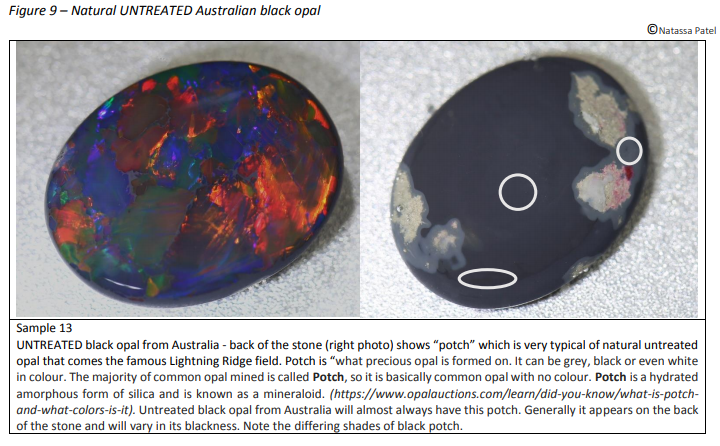
如何鉴别经过处理或造假的蛋白石
 我一直很关注大量经过处理的韦洛蛋白石被当作天然黑蛋白石出售的问题。网上也有很多经过处理的埃塞俄比亚蛋白石被错误地列为天然蛋白石。同样重要的是,这些蛋白石也在澳大利亚的零售店出售,而且不幸的是,在蛋白石矿区也能看到它们的身影。我请拥有宝石学荣誉学位(泰国AIGS)的娜塔莎·帕特尔(Natasha Patel)研究如何在蛋白石矿区或无法使用实验室检测设备的情况下,辨别天然或经过处理的宝石。
我一直很关注大量经过处理的韦洛蛋白石被当作天然黑蛋白石出售的问题。网上也有很多经过处理的埃塞俄比亚蛋白石被错误地列为天然蛋白石。同样重要的是,这些蛋白石也在澳大利亚的零售店出售,而且不幸的是,在蛋白石矿区也能看到它们的身影。我请拥有宝石学荣誉学位(泰国AIGS)的娜塔莎·帕特尔(Natasha Patel)研究如何在蛋白石矿区或无法使用实验室检测设备的情况下,辨别天然或经过处理的宝石。
这是娜塔莎·帕特尔的研究报告《天然黑欧泊——你问对问题了吗?》的副本。
“天然黑欧泊”这个词有时可能并不像我们想象的那样清晰明了。
这块蛋白石是天然的吗?是的
这颗蛋白石是黑色的吗?是的
这些文字并未说明黑欧泊中的黑色是否天然。近年来,市场上充斥着大量所谓的黑欧泊,其中不乏来自埃塞俄比亚的染色、烟熏或糖酸处理过的黑欧泊。关于这些处理工艺的文献资料模糊不清,且不完整。业内人士只能依靠一些临时性的方法来鉴别处理方式。本研究、分析和讨论旨在帮助确定黑欧泊中的黑色是否是人为处理的结果。
正确的问题是:这块黑欧泊是否经过处理?
为什么要问这个问题?因为价值。消费者被误导,以为自己买到的是来自澳大利亚的天然未经处理的黑欧泊,而实际上他们买到的往往是经过大幅处理、呈现出黑色的水晶欧泊。处理过的黑欧泊和未经处理的黑欧泊价格差异可高达500%。
https://www.gia.edu/doc/WN11.pdf (第79页)展示了处理前后的对比图片,清晰地展现了原始蛋白石与最终成品之间的巨大差异。需要注意的是,即使是未经处理的蛋白石,也可以通过处理改变其体色,使其从透明晶体/白色变为黑色或其深浅不一的颜色。
产自埃塞俄比亚的经过处理的黑欧泊在批发市场上的价格约为每克拉10美元。而外观完全相同的未经处理的黑欧泊,价格可能高达每克拉5000美元,有时甚至更高。

一些基本知识
黑欧泊在贸易中有时也被称为深色体色宝石。天然未经处理的黑欧泊主要产自澳大利亚,但也曾在埃塞俄比亚、美国、捷克、匈牙利、墨西哥以及最近的印度尼西亚被发现。
对于蛋白石行业的矿工、批发商和贸易商来说,处理成黑色的蛋白石与天然黑色蛋白石容易混淆,这是一个至关重要的问题。在这种情况下,隐瞒真相无异于撒谎。购买蛋白石的消费者常常因为信息误导和缺乏相关知识而上当受骗。有人可能会说,处理过的黑色蛋白石在市场上占有一席之地。我个人以及大多数蛋白石供应商都同意这种观点。然而,至关重要的是,它的市场份额不能建立在虚假和误导性信息之上。
本报告旨在探讨以下问题:
1. 请注意,天然黑欧泊可能经过处理,使其体色由透明变为黑色。关键在于“未经处理的天然黑欧泊”。
2. 为那些可能对黑欧泊缺乏经验的人提供一些指导原则和技巧,以便识别和区分经过处理的黑欧泊和未经处理的黑欧泊。
3. 至少要注意,黑蛋白石的体色可能是处理方法的直接结果。
4. 购买蛋白石时,现场/市场附近可能没有知名的实验室。
5. 一颗黑欧泊石可能不值得支付知名实验室收取的处理检测费用。6. 可能无法使用大型宝石学设备,例如显微镜、紫外光谱仪等。

我们采用简单的现场检测方法,对15颗天然黑欧泊进行了测试,以探索检测其是否经过处理的途径。测试结果详见本报告附录A。这些样本包括产自澳大利亚、埃塞俄比亚和印度尼西亚的黑欧泊(经处理和未经处理的)。请注意,宝石学检测结果证实,所有15个样本均为天然黑欧泊。
测试中使用的是一些简单的工具,例如人们在购买宝石时可能随身携带或能够获得的工具:
火炬
规模
中性色容器,内装水
环/面罩
钢笔/铅笔
一段可弯曲的金属丝或绳子
检测处理过的黑埃塞俄比亚蛋白石的概要
未经处理的黑色/深色埃塞俄比亚蛋白石,其体色根本不是黑色。在光照和放大镜下观察,它更像是深棕色。
未经处理的各种产地的蛋白石中,有些是不透明的(无法透过它看到另一侧),有些是半透明的(缺乏完全的透明度),这与经过染色/烟熏处理的埃塞俄比亚蛋白石完全透明的样品截然不同。
大多数来自埃塞俄比亚的经过处理的黑欧泊,在强烈的黄色光线从宝石下方近距离照射时,会呈现深樱桃红色的透明度。
处理后的黑蛋白石样品的比重明显低于平均值。
将黑蛋白石浸入水中后,更容易观察到其处理痕迹。
大多数经过处理的黑欧泊都会出现染色/烟熏痕迹,表明黑欧泊中的黑色并非天然形成。
使用手机摄像头仔细观察宝石的外观,这有助于检测宝石是否经过处理。
务必使用白光。白光(对我们肉眼而言)呈黄色,包含了所有可见光谱的颜色,这对于观察任何宝石的真实颜色都至关重要。
黑欧泊是地球上最稀有的宝石之一。务必谨慎。
当石头呈高拱形时
-当石头通体着色时(颜色变化在石头的正面/背面和侧面都可见)。
天然未经处理的黑欧泊中,高穹顶和饱满色彩的组合极为罕见。

通过对测试结果的分析得出的结论
1. 使用光线和放大镜观察本体颜色和基质可见性
a.对于未经处理的天然黑蛋白石,在强光和放大镜下观察会发现,其主体颜色并非真正的黑色,通常是深棕色或灰色。如果您被颜色分散了注意力,请将目光集中在颜色最少或没有颜色的区域。
b.所有未经处理的“黑蛋白石”样品都含有部分基质(母岩或无色/普通蛋白石)和包裹体。基质和有色蛋白石的硬度差异相当显著,处理可能会导致宝石破裂。
如果宝石主体颜色为纯黑色且完全没有基质,请务必谨慎。请注意,基质的存在并不意味着宝石未经处理(一些经过处理的黑蛋白石也可能带有基质)。图 1 中的样品 3 和 5 就是主体颜色为纯黑色的典型例子。
2. 使用透射光(手电筒光源从下方照射)时,石头本体颜色发生变化
这个测试非常简单,可以作为判断黑蛋白石中黑色来源是否值得警惕的初步方法。用白光(呈黄色,包含整个可见光谱)照射。手电筒和宝石尽可能靠近。从各个角度观察宝石(翻转宝石,使背面朝上)。这个测试方法适用于较小的宝石。
a.从下方用透射光(手电筒)观察时,所有经过处理的埃塞俄比亚样品的体色都完全透明(透光)。
b.更重要的是,可以看到透明颜色的色调——一种独特的樱桃红。
c.其他天然黑色/深色蛋白石(透明时)呈现更偏黄/灰色的透明体色。
d.所有未经处理的样品都只有部分透明,大多数情况下完全不透明。
如果从下方用光源照射时,蛋白石的透明度变为樱桃红色,则需格外小心。
从下面的照片中可以明显看出透明度的颜色差异。

3. 比重测试
比重是指宝石重量与其体积的比值。所有宝石的比重各不相同,这项测试是所有大大小小的宝石鉴定实验室的常规操作。计算公式为:

蛋白石的比重平均值为 2.12,范围为 1.75 至 2.23。经处理的埃塞俄比亚黑蛋白石样品的比重值始终接近该范围的下限(见附录 A)。它们的比重值均远低于平均值 2.12。所有经处理的埃塞俄比亚蛋白石的比重值均接近 1.75,而所有未经处理的黑蛋白石的比重值均接近 2.0。
网上有很多关于如何自制比重测试套件的教程。信誉良好的宝石检测设备制造商也以合理的价格出售套件。使用精度至少为0.01克拉(小数点后两位)且分辨率至少为0.01克拉(精确到0.01克拉)的克拉秤。当宝石的比重接近1.75而非2.12时,务必格外小心。
4. 沉浸式体验——“沉浸式”方式
将石头完全浸入中性色容器中的水中,确实能大大简化判断处理效果的工作。虽然这并非万无一失,但也相差无几了。
染色和烟熏痕迹(黑色浓缩物)会变得更加明显。务必立即借助放大镜/观察镜,在强白光下将宝石浸入水中仔细观察。有时,随着宝石浸泡时间的延长,这些用于诊断处理痕迹的标志似乎会消失。宝石的底色会变得更深(黑色会变得更黑),因此变彩效应会更强,导致这些痕迹不再那么显眼。
浸入式强光照射技术也有助于凸显宝石的真实色泽。以下图片和说明将为您展示一些观察要点。








5. 你的手机摄像头(微距镜头可选)
如今手机的摄像头都具备拍摄变焦照片的功能。手机微距镜头适配器也已上市,价格实惠。这能帮助用户近距离观察宝石,从而做出更明智的治疗决策。
使用变焦功能拍摄效果最佳,同时保持手机与石头之间几厘米的距离。务必将石头浸入水中,并用强光照射石头。记住,石头在水中浸泡的时间越长,染料/烟熏痕迹就越不明显。
如果宝石价格昂贵,且对其处理方式仍有疑问,建议咨询宝石学家的意见。请记住,并非所有实验室的资质都相同。黑欧泊是一种稀有宝石,许多实验室对其鉴定经验不足。最好确保明确提出检测处理方式的要求,并在证书中予以明确说明。
宝石实验室是宝石行业的重要组成部分,但很多时候,它们的作用似乎难以企及。本报告概述的检测方法有助于弥合这一差距。对于那些在外奔波、旅行和采购的人来说,本文提供了相对简便易行的方法来评估来自各种产地的黑欧泊的处理方式。本报告重点探讨了埃塞俄比亚黑欧泊的问题,因为这是目前市场上令人困惑的焦点。宝石行业不断发展,新的发现、新的处理方法和新的需求层出不穷,只有通过知识共享和准确信息的传播,才能维持并增强客户的信心。随着全球贸易的便捷,即使产地在特定地点,也不能百分之百保证所售欧泊产自该地。在澳大利亚的矿业小镇,曾多次出现将染色/烟熏的埃塞俄比亚欧泊冒充“闪电岭黑欧泊”出售的情况。这种经过处理的埃塞俄比亚黑欧泊已经流入所有出产未经处理的黑欧泊的地区,包括澳大利亚、墨西哥和印度尼西亚。寻找值得信赖的供应商,并利用本研究作为指导,帮助识别经过处理(染色/烟熏)的黑蛋白石的迹象。

在网上购买黑欧泊
除比重测试外,供应商还需提供本报告中列出的待售黑欧泊的照片。您的请求应包含以下内容:
浸在水中的石头的特写照片。
黑蛋白石正面和背面的照片。
透射光下的黑蛋白石照片。
总之
收到提醒:
仔细观察这块石头,会发现它的本体颜色是纯黑色,没有基质和杂质。
透过黄光,这块石头呈现出深樱桃红色。
该石头的比重接近最低范围 1.75。
当石头浸入水中(借助强光源和放大镜/面罩)时,几乎立即就能看到明显的染料/烟熏痕迹。
这些测试综合起来可以诊断性地证明,黑蛋白石上的黑色并非天然形成。

建议注意事项
将石头完全浸入水中,以便更容易看到处理痕迹。
利用手机的变焦功能,拍摄更清晰、更聚焦的、显示处理痕迹的结石区域照片。
自制或购买便携式比重测量仪。
购买一支“白光”(全光谱,呈黄色)手电筒。

参考
确保你的研究资料来自可靠且经验丰富的来源。
https://www.gia.edu/gems-gemology/spring-2016-labnotes-hydrophane-opal-treatment
https://www.gia.edu/gems-gemology/winter-2014-gemnews-new-deposit-black-opal-from-ethiopia
https://www.gia.edu/gems-gemology/fa13-ln-technique-hydrophane-opal
本文由 Gem Certify 的 Natassa Patel 撰写。
关于娜塔莎·帕特尔
我从青少年时期就开始接触澳大利亚欧泊。获得工商管理硕士学位后,我加入了家族企业,并在过去的16年中,一直从事切割和原石欧泊的全球贸易。最近,我完成了亚洲宝石学院(泰国)的认证宝石学课程,这使我能够将贸易经验与宝石(尤其是欧泊)的科学知识相结合,从而拥有独特的视角。我的首要任务是弥合宝石实验室和宝石贸易商之间的鸿沟,为此我在黄金海岸设立了宝石认证和咨询服务机构。我的目标是创造资源,并以谦逊的态度就一些问题提出见解,从而促进整个行业的进步,尤其注重提升消费者的知识和信息水平。作为以下协会的成员,我可以汇集自身和他人的经验:欧泊协会、澳大利亚宝石学院、澳大利亚珠宝商协会、国际有色宝石协会和珠宝商警戒委员会。
购买黑蛋白石
搜索Opal Encyclopedia
最新的文章
文章分类
All there is to know about Opals including Black Opals, Ethiopian Opals & Boulder Opal
14文章数
Check out our fascinating information and articles on all things amazing in the Opal world
41文章数


